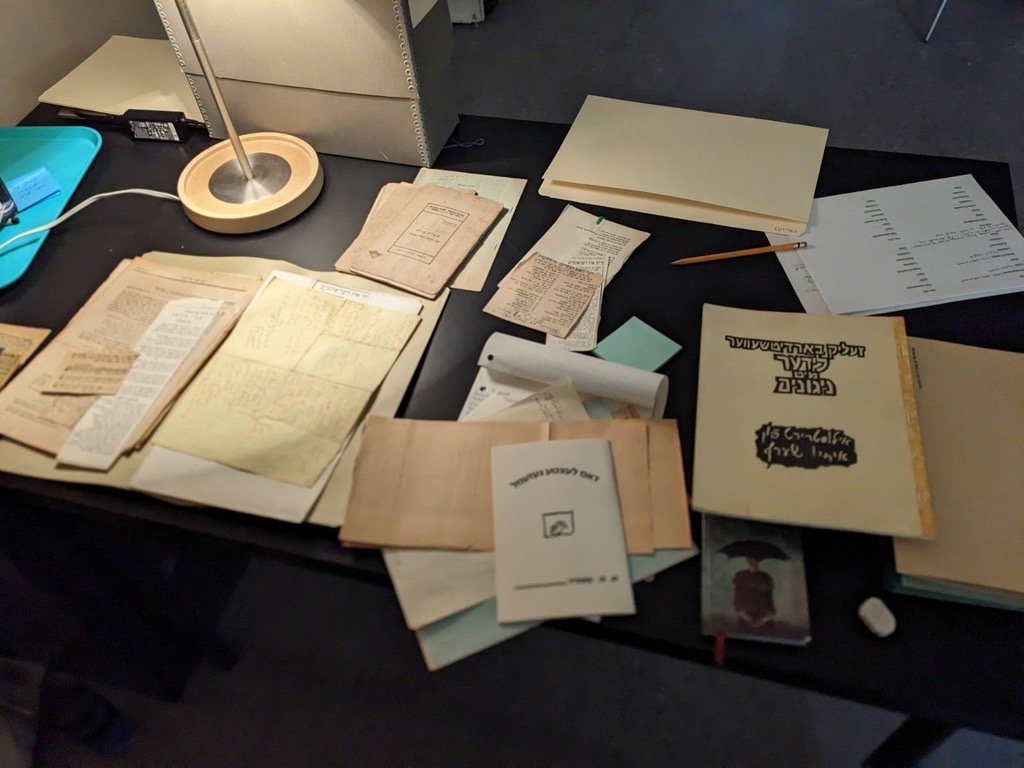My zumer shpatsir at the archive
zumer shpatsir: “summer stroll”
When I was brainstorming how to spend my summer, I knew that I wanted to explore a career opportunity related to Yiddish. Having previously studied the language, I wanted to find a way to utilize what I’d learned outside of the classroom. I already had some experience with my university library and was now interested in working within archiving, which led me to the Jewish Public Library here in Montreal.
I have been fortunate enough to find myself working alongside the archivists at the JPL-A processing several small Yiddish fonds. While I came in with two summers of Yiddish under my belt, I came without any previous archival experience, so my first day was a bit of an adjustment to get used to the layout and how the archive is organized. The main thing to know about an archive is that the stacks are not browsable like in a library, and usually the contents are not displayed like in a museum. Unlike in a library, where a patron can see all the contents of the collection, an archive will typically have stacks upon stacks of containers with innumerable file folders–many of which have been only lightly sorted due to the sheer amount of materials they hold.
So many boxes…
I first began my work with processing Moshe Shaffir’s fonds. With some of the small fonds, it has been some time since their acquisition, and an archivist has yet to look at the contents and to input the information into our new online catalogue. There was a certain thrill when I first opened Shaffir’s container knowing that I had the responsibility to understand its contents and share that. He was a teacher for many years as well as a prolific writer. His fonds was mostly in Yiddish, and contained a plethora of materials including his writings, documents from various events, and his personal correspondence.
His documents were already organized in file folders, so my next step was to go through and pull out metadata to record in the online catalogue. Metadata is one of the most important aspects of archiving—it is the information that describes or informs a set of data. Some examples include information about the provenance and acquisition of material, or the date and location where a document was produced.
I went through all of Shaffir’s materials and dated them, as well as kept track of the subject matter present. After about a month of hard work reading Yiddish newspaper clippings and handwritten letters, matching up Yiddish geographical names to their contemporary English names, and calculating Jewish calendar years and converting them to Gregorian years, I was finally ready to input all this metadata and information into the catalogue. The final product of my work is the online description of the Moshe Shaffir fonds.
After I finished processing Shaffir’s fonds and got used to the workflow and rhythm of the work, processing other fonds became a breeze. I worked on two more fonds this summer, both of prominent Yiddish-speaking Jewish leaders in Montreal; that of Shloime Wiseman, decades-long principal of the Jewish People’s Schools and advocate for Jewish day schools, and Moishe Dickstein, a writer and major supporter of Zionist organizations in Montreal and of Israel.
I have really enjoyed my time here at JPL-A and in Montreal this summer. I’ve learned more about the behind the scenes work of an archive, about the extent of the structure and organization that goes into keeping it running, and how important attention to detail is in this sort of work. I’ve also learned that what you already know is not necessarily as important as your ability to research, find the information that you need, and being ready and willing to learn more. I am really proud of the work I have done this summer, and it has made me all the more excited to continue working in this field!
Thanks for reading and zayt gezunt un shtark! [May you be healthy and strong!]
This is Dina, the summer intern, signing off.



